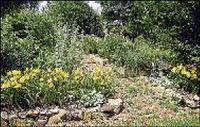
Due to poor clay soil in this kitchen garden, the owners built informal raised beds with the help, essentially, of cement and large rocks to define the various plots. Pleasant walkways meander between the beds.A new garden covered with clay soil can be a serious headache. G.T. tries to come to the rescue by dropping a few pearls of wisdom:
First of all, work in your garden only when it is dry. If you work clay soil while its wet, it can set up like brick. How do you know whether its really dry? If you pick up a handful of soil and can squeeze water from it, its obviously too wet. If the soil compresses into a ball and stays that way, it needs more drying time. If it is dry enough to crumble in your hand, it is friable and is ready to be worked. Simple!
Another warning: adding sand to clay soil can make conditions even worse.
Organic matter, and lots of it, is the best way to improve the quality of clay soil. Sources of organic matter include well-rotten manure, leaves, grass clippings, and the like. You can pile them on top of soil or till them in. Whatever you do, you should wait several weeks before planting to allow time for the material to break down.
Compost is, of course, another key ingredient for improving soil.
To sum it up, clay soil leaves you with two options: A) Learn to grow in clay soils and therefore pick appropriate plants. B) Learn how to modify the soil and widened the planting options.
Having made this pronouncement, I really do have to point out that not all clay soils are created equally. What works in one clay soil type will not work in another. For example, a remedy that is commonly recommended for improving clay soils is adding gypsum to the soil. But this only works if your clay soil is acidic! If your soil is already alkaline, then it wont help, and youre left wondering why.

